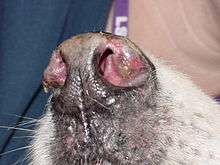Canine discoid lupus erythematosus
Discoid lupus erythematosus (DLE) is an uncommon autoimmune disease of the basal cell layer of the skin. It occurs in humans[1] and cats, more frequently occurring in dogs. It does not progress to systemic lupus erythematosus (SLE) in dogs. SLE can also have skin symptoms, but it appears that the two are either separate diseases or DLE is a mild form of SLE.[2] DLE in dogs differs from SLE in humans in that plasma cells predominate histologically instead of T lymphocytes.[3] Because worsening of symptoms occurs with increased ultraviolet light exposure, sun exposure most likely plays a role in DLE, although certain breeds (see below) are predisposed.[4] After pemphigus foliaceus, DLE is the second most common autoimmune skin disease in dogs.[5]
Symptoms

The most common initial symptom is scaling and loss of pigment on the nose. This is found in up to 90 percent of affected dogs.[2] The surface of the nose becomes smooth gray, and ulcerated, instead of the normal black cobblestone texture. Over time the lips, the skin around the eyes, the ears, and the genitals may become involved.[6] Lesions may progress to ulceration and lead to tissue destruction. DLE is often worse in summer due to increased sun exposure.
Diagnosis
DLE is easily confused with solar dermatitis, pemphigus, ringworm, and other types of dermatitis. Biopsy is required to make the distinction. Histopathologically, there is inflammation at the dermoepidermal junction and degeneration of the basal cell layer.[5] Unlike in SLE, an anti-nuclear antibody test is usually negative.[2]
Treatment
Avoiding sun exposure and the use of sunscreens (not containing zinc oxide, which is toxic to dogs) is important. Topical therapy includes corticosteroid use. Oral vitamin E or omega-3 and omega-6 fatty acids are also used. More refractory cases may require the use of oral niacinamide and tetracycline, corticosteroids, azathioprine, or chlorambucil.[7] Treatment is often lifelong, but there is a good prognosis for long-term remission.
Commonly affected dog breed
Alaskan Malamute
- Collie
- German Shepherd Dog
- Shetland Sheepdog
- Siberian Husky
- Brittany
- German Shorthaired Pointer[3]
- Africanis
See also
References
- ↑ American Osteopathic College of Dermatology, "Discoid Lupus Erythematosus".
- 1 2 3 Ettinger, Stephen J.; Feldman, Edward C. (1995). Textbook of Veterinary Internal Medicine (4th ed.). W.B. Saunders Company. ISBN 0-7216-6795-3. OCLC 28723106.
- 1 2 Griffin, Craig E.; Miller, William H.; Scott, Danny W. (2001). Small Animal Dermatology (6th ed.). W.B. Saunders Company. ISBN 0-7216-7618-9. OCLC 43845516.
- ↑ Mueller, Ralf S. (2005). "Immune-mediated skin diseases" (PDF). Proceedings of the 50° Congresso Nazionale Multisala SCIVAC. Retrieved 2007-03-13.
- 1 2 Osborn, S. (2006). "Autoimmune Diseases in the Dog". Proceedings of the North American Veterinary Conference. Retrieved 2007-03-13.
- ↑ Gerhauser I, Strothmann-Lüerssen A, Baumgärtner W (2006). "A case of interface perianal dermatitis in a dog: is this an unusual manifestation of lupus erythematosus?". Vet Pathol. 43 (5): 761–4. doi:10.1354/vp.43-5-761. PMID 16966456.
- ↑ Griffies J, Mendelsohn C, Rosenkrantz W, Muse R, Boord M, Griffin C (2004). "Topical 0.1% tacrolimus for the treatment of discoid lupus erythematosus and pemphigus erythematosus in dogs". J Am Anim Hosp Assoc. 40 (1): 29–41. PMID 14736903.